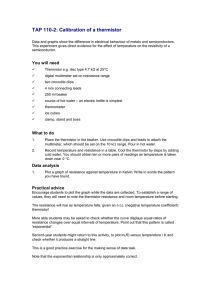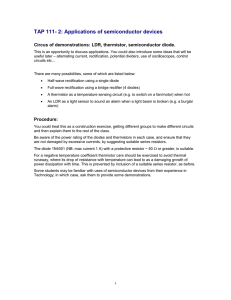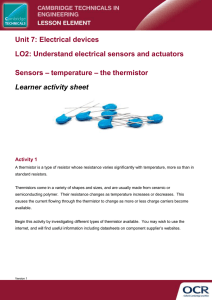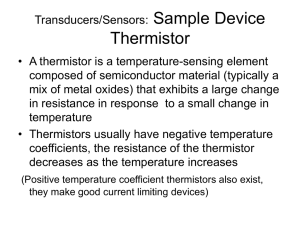Selecting and Using Thermistors for Temperature Control
advertisement
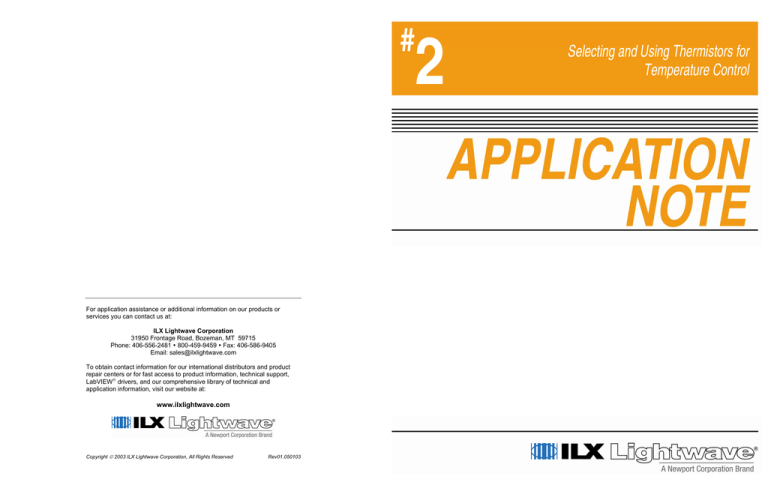
# 2 For application assistance or additional information on our products or services you can contact us at: ILX Lightwave Corporation 31950 Frontage Road, Bozeman, MT 59715 Phone: 406-556-2481 800-459-9459 Fax: 406-586-9405 Email: sales@ilxlightwave.com To obtain contact information for our international distributors and product repair centers or for fast access to product information, technical support, LabVIEW drivers, and our comprehensive library of technical and application information, visit our website at: www.ilxlightwave.com Copyright 2003 ILX Lightwave Corporation, All Rights Reserved Rev01.050103 Selecting and Using Thermistors for Temperature Control Selecting and Using Thermistors for Temperature Control perature. The non-linearity of thermistors complicates their calibration and use. Thermally sensitive resistors (thermistors) are used widely in laser diode and detector cooling applications because of their high sensitivity, small size, ruggedness, fast response times, and low cost. When used properly with a thermoelectric (TE) cooler and support circuitry, a common thermistor costing less than a dollar has enough sensitivity to stabilize the temperature of a laser diode to better than 0.001°C. The price of the thermistor’s high sensitivity is paid with non-linearity, a factor which makes their selection and use a bit more challenging than might be otherwise expected. In the past, design engineers often resorted to resistor-based linearizing networks which effectively converted resistance to temperature only over very narrow temperature ranges. Fortunately, microprocessors have greatly simplified this task with their ability to quickly calculate complex expressions. The R-T characteristics of most thermistors are accurately described by the Steinhart-Hart equation: 1/T = A + B*(Ln R) + C*(Ln R)3 Thermistor Characteristics In this relationship, T is the absolute temperature (in Kelvin) and A, B, and C are constants which can be determined from mea Thermistors are generally two-terminal semiconductor devices that have an electrical resistance that varies non-linearly with tem- Thermistor R/T Curves For Varying Room Temperature Resistances 50 Resistance (thousands) 40 30 20 500 1K 2.5K 5K 10K 25K 50K 100K 10 250 0 -60 -40 -20 0 20 40 60 80 100 120 140 160 Temperature (oC) Figure 1. Resistance-Temperature response curves for nine common thermistors. 1 sured values of resistance and temperature(1). Assuming good calibration data is available(2), the Steinhart-Hart equation introduces errors of less than 0.1°C over a temperature range of -30°C to +125°C, and errors of less than 0.01°C between -20°C to +50°C. 10 9 Resistance (thousands) 8 Thermistor Families - Most thermistors have a negative temperature coefficient (NTC), which means resistance decreases with increasing temperature. The R-T characteristics of nine common NTC thermistors are shown in Figure 1. Each thermistor is labeled according to its nominal resistance at 25°C; commonly available thermistors range from 250 Ω to 100 kΩ. 7 6 5 4 3 2 1 0 Course resistance control is accomplished during the thermistor manufacturing process by using different metal oxides to form the semiconductor junction. Several different material combinations are used to arrive at the same nominal 25°C resistance, and each combination leads to a slightly different R-T characteristic. This variety of available R-T characteristics often seems to complicate thermistor selection. However, as shown in Figure 2, the differences between thermistors of the same nominal resistance are relatively small. -40 -20 0 20 40 60 80 Temperature (oC) Figure 2. R-T slope changes for differing thermistor materials. Temperature Sensitivity - Thermistors achieve their highest sensitivity at low temperatures, where the resistance vs. temperature curve is steepest. This sensitivity drops rapidly as the temperature increases. For a typical 10 kΩ thermistor, the sensitivity varies as follows: Nominal Resistance - Generally, thermistors are operated at temperatures where they exhibit resistances of thousands of ohms. At these high resistances, simple two-wire resistance measurements work well using conventional digital multimeters, and the measurement circuitry of temperature controllers does not have to be overly complicated or precise for reliable temperature measurement. Temperature -20°C 25°C 50°C Sensitivity 5,600 Ω/°C 439 Ω/°C 137 Ω/°C 1 - Calculation of the constants A, B, and C is discussed in detail in ILX Lightwave’s Application Note #4. 2 - These constants are supplied to the user with the purchase of any ILX Lightwave product which uses thermistors for temperature control, such as the LDT-5900 Series instruments. 2 Temperature Range and Thermistor Selection To understand practical thermistor selection trade-offs, consider the system block diagram shown in Figure 3. This figure shows a temperature sensing and display system like the one used in the LDT-5900 Series and other ILX temperature controllers. Thermistor resistance is sensed by forcing a constant current, either 10 µA or 100 µA, through the thermistor and then measuring the voltage drop. The voltage is digitized and then input to the microprocessor, the resistance is calculated, and the Steinhart-Hart equation is used to calculate temperature. Figure 3. High resolution temperature measurement system. The LDT-5900 Series instruments use a 23-bit A/D converter over a measurement range of 0 – 6V, resulting in an A/D input voltage resolution of about 0.7µV per step. Since the thermistor resistance is non-linear, the actual temperature measurement resolution is also non-linear. This non-linearity complicates the definition of the temperature measurement limits. The display resolution of the LDT-5900 Series is 0.001°C. As long as a single A/D bit corresponds to a change of less than 0.001°C, the measurement resolution does not significantly impact the instrument application. The temperatures at which a single A/D step corresponds to a change of greater than 0.001°C are as follows: As the thermistor temperature increases, its resistance and sensitivity to temperature change also decrease. This means that the number of ohms per bit decreases and the number of degrees per A/D step increases. Figure 4 illustrates this relationship. The upper part of the figure shows the thermistor resistance and voltage input to the A/D, and is used to determine the low temperature limit of the system. The lower part of the figure shows the system measurement resolution in degrees C per A/D converter step, and is used to determine the upper temperature limit. Sensing Current ∆R/0.001°C 10kΩ Thermistor Temp. 10 µA 0.07Ω 64°C 100 µA 0.007Ω 132°C At temperatures higher than these, a single A/D step corresponds to more than 0.001°C in temperature change, and the instrument can no longer detect and measure temperature changes smaller than 0.001°C. As the thermistor temperature decreases its resistance increases and, likewise, so does the voltage across it. The practical lower temperature limit is reached when the voltage exceeds 3 LDT-5900 Series Temperature Range Using Typical 10 kΩ Thermistor 7 Max A/D Voltage 6 A/D Voltage (V) 5 4 3 2 1 0 -60 -40 -20 0 20 40 60 80 100 120 140 10 µA 100 µA 0.00150 Resolution (˚C/bit) 0.00125 Min A/D Resolution 0.00100 0.00075 0.00050 0.00025 0.00000 -60 -40 -20 0 20 40 60 80 100 Temperature (˚C) Figure 4. Measurement Resolution Change vs. Temperature 4 120 140 the maximum input voltage of the A/D converter. Typical low temperature measurement limits are: Sensing Current 10 µA 100 µA Resistance 600,000Ω 60.000Ω 10kΩ Thermistor Temp. -49°C -11°C Conclusion The type of thermistor you choose will depend primarily on the required operating temperature range. Thermistor R-T curves, like Figure 1, are usually supplied by the thermistor manufacturer, and provide a good guideline for thermistor selection. The useful temperature range of a thermistor is shifted by varying the sensing current. The temperature ranges for the LDT-5900, using a 10 kΩ thermistor, are shown by the horizontal bars in the center of Figure 4, and can be shifted dramatically by changing the sense current. Figure 4 provides data for a typical 10 kΩ thermistor, but the same approach can be used with other thermistors. From the figure you can see that 10 kΩ thermistors are generally a good choice for most laser diode cooling applications where high stability is required from just above room temperature to approximately -40°C. 5 The following publications are available for download on at www.ilxlightwave.com. White Papers • A Standard for Measuring Transient Suppression of Laser Diode Drivers • Degree of Polarization vs. Poincaré Sphere Coverage • Improving Splice Loss Measurement Repeatability Technical Notes • Attenuation Accuracy in the 7900 Fiber Optic Test System • Automatic Wavelength Compensation of Photodiode Power Measurements Using the OMM-6810B Optical Multimeter • Bandwidth of OMM-6810B Optical Multimeter Analog Output • Broadband Noise Measurements for Laser Diode Current Sources • Clamping Limit of a LDX-3525 Precision Current Source • Control Capability of the LDC-3916371 Fine Temperature Resolution Module • Current Draw of the LDC-3926 16-Channel High Power Laser Diode Controller • Determining the Polarization Dependent Response of the FPM-8210 Power Meter • Four-Wire TEC Voltage Measurement with the LDT-5900 Series Temperature Controllers • Guide to Selecting a Bias-T Laser Diode Mount • High Power Linearity of the OMM-6810B and OMH-6780/6790/ 6795B Detector Heads • Large-Signal Frequency Response of the 3916338 Current Source Module • Laser Wavelength Measuring Using a Colored Glass Filter • Long-Term Output Drift of a LDX-3620 Ultra Low-Noise Laser Diode Current Source • Long-Term Output Stability of a LDX-3525 Precision Current Source • Long-Term Stability of an MPS-8033/55 ASE Source • LRS-9424 Heat Sink Temperature Stability When Chamber Door Opens • Measurement of 4-Wire Voltage Sense on an LDC-3916 Laser Diode Controller • Measuring the Power and Wavelength of Pulsed Sources Using the OMM-6810B Optical Mutlimeter • Measuring the Sensitivity of the OMH-6709B Optical Measurement Head • Measuring the Wavelength of Noisy Sources Using the OMM-6810B Optical Multimeter • Output Current Accuracy of a LDX-3525 Precision Current Source • Pin Assignment for CC-305 and CC-505 Cables • Power and Wavelength Stability of the 79800 DFB Source Module • Power and Wavelength Stability of the MPS-8000 Series Fiber Optic Sources • Repeatability of Wavelength and Power Measurements Using the OMM-6810B Optical Multimeter • Stability of the OMM-6810B Optical Multimeter and OMH-6727B InGaAs Power/Wavehead • Switching Transient of the 79800D Optical Source Shutter • Temperature Controlled Mini-DIL Mount • Temperature Stability Using the LDT-5948 • Thermal Performance of an LDM-4616 Laser Diode Mount • Triboelectric Effects in High Precision Temperature Measurements • Tuning the LDP-3840 for Optimum Pulse Response • Typical Long-Term Temperature Stability of a LDT-5412 Low-Cost TEC • Typical Long-Term Temperature Stability of a LDT-5525 TEC • Typical Output Drift of a LDX-3412 Loc-Cost Precision Current Source • Typical Output Noise of a LDX-3412 Precision Current Source • Typical Output Stability of the LDC-3724B • Typical Output Stability of a LDX-3100 Board-Level Current Source • Typical Pulse Overshoot of the LDP-3840/03 Precision Pulse Current Source • Typical Temperature Stability of a LDT-5412 Low-Cost Temperature Controller • Using Three-Wire RTDs with the LDT-5900 Series Temperature Controllers • Voltage Drop Across High Current Laser Interconnect Cable • Voltage Drop Across High Current TEC Interconnect Cable • Voltage Limit Protection of an LDC-3916 Laser Diode Controller • Wavelength Accuracy of the 79800 DFB Source Module Application Notes • App Note 1: Controlling Temperatures of Diode Lasers and Detectors Thermoelectrically • App Note 2: Selecting and Using Thermistors for Temperature Control • App Note 3: Protecting Your Laser Diode • App Note 4: Thermistor Calibration and the Steinhart-Hart Equation • App Note 5: An Overview of Laser Diode Characteristics • App Note 6: Choosing the Right Laser Diode Mount for Your Application • App Note 8: Mode Hopping in Semiconductor Lasers • App Note 10: Optimize Testing for Threshold Calculation Repeatability • App Note 11: Pulsing a Laser Diode • App Note 12: The Differences between Threshold Current Calculation Methods • App Note 13: Testing Bond Quality by Measuring Thermal Resistance of Laser Diodes • App Note 14: Optimizing TEC Drive Current • App Note 17: AD590 and LM335 Sensor Calibration • App Note 18: Basic Test Methods for Passive Fiber Optic Components • App Note 20: PID Control Loops in Thermoelectric Temperature Controllers • App Note 21: High Performance Temperature Control in Laser Diode Test Applications # 2 For application assistance or additional information on our products or services you can contact us at: ILX Lightwave Corporation 31950 Frontage Road, Bozeman, MT 59715 Phone: 406-556-2481 800-459-9459 Fax: 406-586-9405 Email: sales@ilxlightwave.com To obtain contact information for our international distributors and product repair centers or for fast access to product information, technical support, LabVIEW drivers, and our comprehensive library of technical and application information, visit our website at: www.ilxlightwave.com Copyright 2003 ILX Lightwave Corporation, All Rights Reserved Rev01.050103 Selecting and Using Thermistors for Temperature Control
